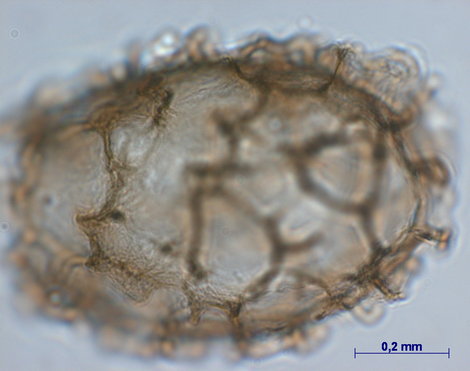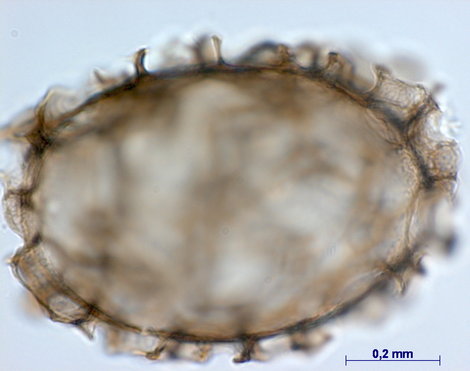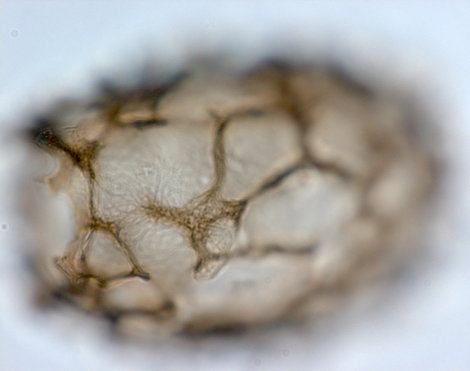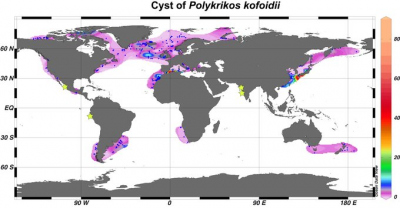Page path:
- Modern Dinocyst Key
- brown cysts
- brown elongate cysts
- cyst of Polykrikos kofoidii
cyst of Polykrikos kofoidii
Zonneveld, K.A.F. and Pospelova V. (2015). A determination key for modern dinoflagellate cysts. Palynology 39 (3), 387- 407.

lateral view
photo: Karin Zonneveld
locality: Adriatic Sea
photo: Karin Zonneveld
locality: Adriatic Sea

cross section
photo: Karin Zonneveld
photo: Karin Zonneveld

lateral view 2
photo: Karin Zonneveld
photo: Karin Zonneveld
Field Characteristics
Cyst of Polykrikos kofoidii Chatton 1914
Characteristics:
Proximate cyst of elongate shape, brown to greenish brown in colour. The wall consists on two to three layers. The endophragm is thick and smooth and the periphragm is thin, smooth with high fibrous crests and muri forming a reticulate ornaments. The distal parts from the muri are wrinkled. The height of the muri is almost constant in each individual specimen. In optical cross section the muri look like small slender processes with recurved distal extremities. The diameter of the reticulation varies from 6 to 17 µm. A further outer membrane, ectophragm, may or may not be present. A parasulcal area may be seen in some specimens directly below the sulcal notch of the archeopyle margin. Archeopyle is presumed apical, with the archeopyle margin possibly displaying the anterior margins of several lumina and formed by the loss of one or more whorls of lumina
Dimensions: Cyst body: 48 to 63 (width) x 72 to 125 (length) µm; length of ornaments: 6 to 11 µm.
Motile affinity: Polykrikos kofoidii
Cyst theca relationship: (Wall and dale 1968) Matsuoka 2009
Stratigraphic range: Upper Quaternary to Recent.
Comparison with other species:
Cysts of P. kofoidii can be distinguished by cysts of Polykrikos schwartzii in having an irregular course reticulation that consist of connected muri.
Characteristics:
Proximate cyst of elongate shape, brown to greenish brown in colour. The wall consists on two to three layers. The endophragm is thick and smooth and the periphragm is thin, smooth with high fibrous crests and muri forming a reticulate ornaments. The distal parts from the muri are wrinkled. The height of the muri is almost constant in each individual specimen. In optical cross section the muri look like small slender processes with recurved distal extremities. The diameter of the reticulation varies from 6 to 17 µm. A further outer membrane, ectophragm, may or may not be present. A parasulcal area may be seen in some specimens directly below the sulcal notch of the archeopyle margin. Archeopyle is presumed apical, with the archeopyle margin possibly displaying the anterior margins of several lumina and formed by the loss of one or more whorls of lumina
Dimensions: Cyst body: 48 to 63 (width) x 72 to 125 (length) µm; length of ornaments: 6 to 11 µm.
Motile affinity: Polykrikos kofoidii
Cyst theca relationship: (Wall and dale 1968) Matsuoka 2009
Stratigraphic range: Upper Quaternary to Recent.
Comparison with other species:
Cysts of P. kofoidii can be distinguished by cysts of Polykrikos schwartzii in having an irregular course reticulation that consist of connected muri.
Geographic Distribution
Geographic distribution based on :
Zonneveld et al., 2013. Atlas of modern dinoflagellate cyst distribution based on 2405 datapoints. Review of Palaeobotany and Palynology, v. 191, 1-197
Zonneveld et al., 2013. Atlas of modern dinoflagellate cyst distribution based on 2405 datapoints. Review of Palaeobotany and Palynology, v. 191, 1-197
Cysts of Polykrikos kofoidii can be observed in sub-tropical to sub-polar Northern Hemisphere and in the temperate southern Hemisphere. Although it occurs generally in coastal regions where full-marine conditions prevail although it is not restricted to that. It occurs also in the open ocean and at sites where upper water salinities are reduced throughout the year. The species has a broad distribution with respect to the upper water trophic state and bottom water oxygen concentrations.

Distribution:
Polykrikos kofoidii has a bipolar distribution. On the Northern Hemisphere it is mainly observed in the sub-polar and temperate coastal as well as open oceanic sites. On the Southern Hemisphere it occurs mainly in coastal sites in temperate regions. Highest abundances (up to 51%) occur in the Western Mediterranean Sea and the East China Sea. Although it is mainly registered from coastal areas it is observed in relatively high relative abundances in some parts of the central oceans as well.
Environmental parameters:
SST: -1.6 - 29.8°C (winter - summer) with summer SST > 0°C, SSS: 17.5 - 38.7 (summer - summer), [P]: 0.06 - 1.73 μmol/l, [N]: 0.04 - 18.5 μmol/l, chlorophyll-a: 0.08 - 21.7 ml/l, bottom water [O2]: 0.01 - 7.3 ml/l.
Comparison with other records:
Apart from the distribution recorded in this Atlas, Polykrikos kofoidii has been documented from several sites along the western Indian coast (Indian Ocean), in the upwelling area of Peru and along the western Mexican coast (central Eastern Pacific, Biebow et al., 1993; Godhe et al., 2000; D'Costa et al., 2008; Limoges et al., 2010).
Sediment trap and seasonal distribution studies do not reveal a clear seasonal pattern in the cyst production of Polykrikos kofoidii (Fujii and Matsuoka, 2006; Ribeiro and Amorim, 2008; Pospelova et al., 2010a; Price and Pospelova, 2011). In the Saanich Inlet (BC, Canada) slightly enhanced flux rates occurred when upper water salinity and temperatures were reduced due to Cowichan River discharge (Price and Pospelova, 2011). Polykrikos kofoidii occurs generally in ice-free environments although it has sporadically been found in arctic sites where seasonal ice cover can last for 4 months (de Vernal et al., 1998). However, ice cover duration correlates negatively with relative abundances of this species in the arctic (Radi and de Vernal, 2008).
Polykrikos kofoidii/schwartzii are often characteristically present in highly polluted coastal waters and are thought to be typical for areas where human-induced eutrophication occurs (Pospelova et al., 2002; Pospelova et al., 2004; Pospelova et al., 2005; Dale, 2009; Kim et al., 2009; Pospelova and Kim, 2010; Zonneveld et al., 2012). Unfortunately it is not always clear which of the two species (P. kofoidii or P. schwartzii) has been recorded or if they have been separated at all. In general cysts of Polykrikos schwartzyii are more common in the Pacific coastal waters whereas cysts of P. kofoidii are more common in the Atlantic.
Polykrikos kofoidii has a bipolar distribution. On the Northern Hemisphere it is mainly observed in the sub-polar and temperate coastal as well as open oceanic sites. On the Southern Hemisphere it occurs mainly in coastal sites in temperate regions. Highest abundances (up to 51%) occur in the Western Mediterranean Sea and the East China Sea. Although it is mainly registered from coastal areas it is observed in relatively high relative abundances in some parts of the central oceans as well.
Environmental parameters:
SST: -1.6 - 29.8°C (winter - summer) with summer SST > 0°C, SSS: 17.5 - 38.7 (summer - summer), [P]: 0.06 - 1.73 μmol/l, [N]: 0.04 - 18.5 μmol/l, chlorophyll-a: 0.08 - 21.7 ml/l, bottom water [O2]: 0.01 - 7.3 ml/l.
Comparison with other records:
Apart from the distribution recorded in this Atlas, Polykrikos kofoidii has been documented from several sites along the western Indian coast (Indian Ocean), in the upwelling area of Peru and along the western Mexican coast (central Eastern Pacific, Biebow et al., 1993; Godhe et al., 2000; D'Costa et al., 2008; Limoges et al., 2010).
Sediment trap and seasonal distribution studies do not reveal a clear seasonal pattern in the cyst production of Polykrikos kofoidii (Fujii and Matsuoka, 2006; Ribeiro and Amorim, 2008; Pospelova et al., 2010a; Price and Pospelova, 2011). In the Saanich Inlet (BC, Canada) slightly enhanced flux rates occurred when upper water salinity and temperatures were reduced due to Cowichan River discharge (Price and Pospelova, 2011). Polykrikos kofoidii occurs generally in ice-free environments although it has sporadically been found in arctic sites where seasonal ice cover can last for 4 months (de Vernal et al., 1998). However, ice cover duration correlates negatively with relative abundances of this species in the arctic (Radi and de Vernal, 2008).
Polykrikos kofoidii/schwartzii are often characteristically present in highly polluted coastal waters and are thought to be typical for areas where human-induced eutrophication occurs (Pospelova et al., 2002; Pospelova et al., 2004; Pospelova et al., 2005; Dale, 2009; Kim et al., 2009; Pospelova and Kim, 2010; Zonneveld et al., 2012). Unfortunately it is not always clear which of the two species (P. kofoidii or P. schwartzii) has been recorded or if they have been separated at all. In general cysts of Polykrikos schwartzyii are more common in the Pacific coastal waters whereas cysts of P. kofoidii are more common in the Atlantic.


